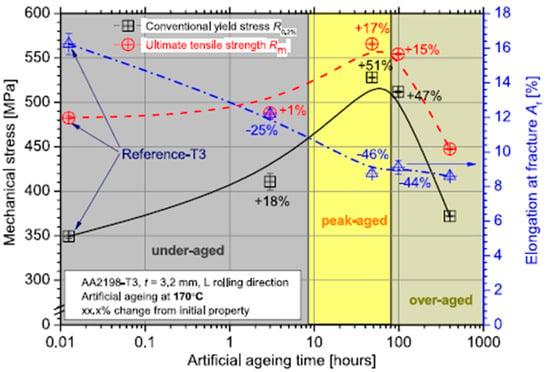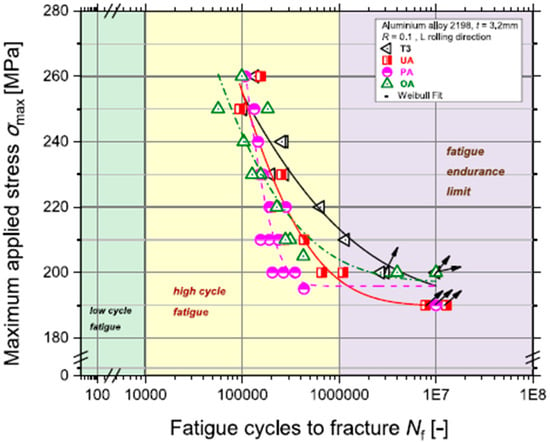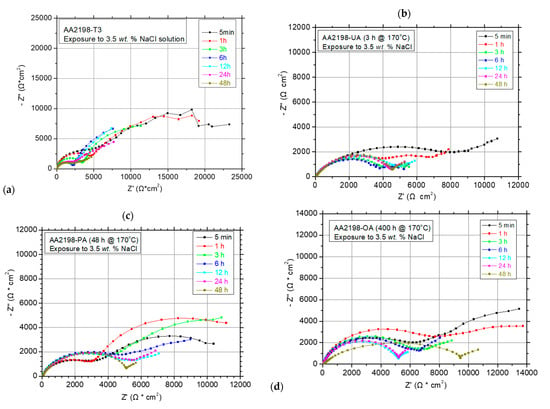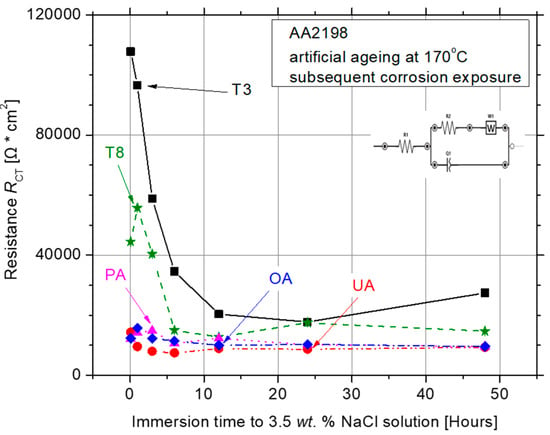Abstract
In the present article, the effect of artificial ageing on tensile mechanical properties and resistance to corrosion of aluminium alloy 2198-T3 was investigated. The results were obtained under the framework of the Greek National project “CorLi”, which was targeted to document the mechanical behaviour of the alloy under different artificial ageing conditions, simulating the natural ageing of aircraft structures during their operation lifespan. Four (4) different ageing conditions corresponding to under-aged (UA), peak-aged (PA), and over-aged (OA) tempers based on the initial, T3 temper, were considered. In the PA condition, the conventional yield stress Rp0.2% increased by more than 50% with a simultaneous 46% decrease in tensile elongation at fracture Af. Additionally, the effect of corrosion was found to be different for the different artificial ageing tempers of AA2198, with lower charge transfer resistance (RCT) observed for artificially aged specimens. Nevertheless, the corrosion-induced degradation rate of RCT was found to decrease with increasing ageing time.
1. Introduction
Al-Cu-Li alloys, proposed to replace conventional Al-Cu alloys in aircraft structures, are beneficial due to significant weight savings, improved mechanical strength properties and corrosion resistance. These alloys derive their strength from intermetallic phases such as T1 (Al2CuLi), θ (and its metastable precursors) (Al2Cu), S (Al2CuMg), and δ’ (Al3Li) []. T1 is the primary strengthening phase, acting as a non-shearable obstacle [,], which nucleates on dislocations and grain boundaries [,]. Phase competition depends on Cu/Li ratios, minor solutes, and thermomechanical history [,].
Various approaches, including artificial ageing heat treatments, have been employed to simulate natural ageing in aluminium alloys by accelerating microstructural transformations and evaluating their impact on mechanical properties. Alexopoulos et al. [] observed that artificial ageing significantly increased the yield stress while reducing elongation at fracture (ductility) in AA2024-T3 due to S-phase precipitation. Hardness improvements with ageing time were reported by Astika [], while Ringer et al. [] linked the hardness changes to precipitate type, size, and distribution. Zhang et al. [] noted changes in precipitate composition and fracture mechanisms in AA2198 with ageing time. In Al-Cu-Li alloys, ageing progresses through the following sequence: SSS (solute solid solution) → δ’, and θ’, T1 → θ, T1, with over-ageing temper degrading mechanical properties due to incoherent θ phase formation and precipitate coarsening [,].
Artificial ageing treatments significantly influence the corrosion behaviour of aluminium alloys, particularly through galvanic interactions between intermetallic phases and the matrix. For AA2024, phases like θ and S along grain boundaries contribute to intergranular corrosion (IGC) and exfoliation corrosion (EXCO) []. Wang et al. [] reported that S-phase precipitates in over-aged samples accelerated anodic dissolution, while Alexopoulos et al. [] linked corrosion-induced tensile ductility loss to S-phase precipitation, with peak-aged and over-aged conditions exhibiting lower corrosion-induced ductility reduction compared to the T3 temper.
For Al-Cu-Li alloys, including AA2198, corrosion susceptibility is closely related to thermomechanical treatments and microstructural changes. The T8 temper of AA2099 demonstrated higher susceptibility to localised corrosion, while in AA1460, δ′ (Al3Li) and T1 (Al2CuLi) phases within grains and near grain boundaries strongly influenced electrochemical behaviour []. In AA2198, the evolution of inter- to intragranular precipitation under artificial ageing likely plays a pivotal role in localised corrosion resistance due to the change from intergranular to transgranular corrosion attack, but the driving mechanisms of corrosion in different ageing tempers remain poorly understood.
In the present article, the effect of different artificial ageing tempers on the mechanical and corrosion behaviour of Al-Cu-Li alloy 2198 is investigated. Rectangular blocks and flattened-end tensile specimens, artificially aged to different tempers corresponding to under-aged (UA), peak-aged (PA), and over-aged (OA) tempers, selected from a relevant article of the authors (referred to in endnote []), and subsequently exposed to corrosion environment for different exposure times to investigate the rate of corrosion-induced ductility degradation in different ageing tempers.
2. Materials and Methods
The material used was a wrought aluminium alloy (AA) 2198-T3 received in sheet form of nominal thickness equal to 3.2 mm. According to the sheet manufacturer, the nominal chemical composition of AA2198 consists of the following elements as percentage by weight: 2.9–3.5% Cu, 0.8–1.1% Li, ≤ 0.35% Zn, ≤ 0.5% Mn, 0.25–0.8% Mg, 0.04–0.18% Zr, ≤ 0.08% Si, 0.1–0.5% Ag, ≤ 0.01% Fe, and Al remaining. Tensile specimens as well as rectangular coupons were machined from the longitudinal (L) rolling direction of the sheet in accordance with ASTM E8 specifications. The geometrical dimensions of the tensile specimens were 12.5 mm × 3.2 mm at the reduced cross-section, with a total length of 190 mm, while the respective dimensions for the rectangular blocks were 10 mm × 20 mm × 3.2 mm.
To simulate natural ageing in AA2198-T3, isothermal artificial ageing at 170 °C was performed, following the recommendations provided in []. Lower ageing temperatures promote higher peak mechanical strength by balancing the formation of coherent and semi-coherent precipitates []. Four (4) different ageing times—3 h, 48 h, 98 h, and 400 h—were investigated, representing under-aged (UA), peak-aged (PA), over-aged (OA), and extreme over-aged (EOA) conditions, respectively []. Yield stress increased up to 48 h (UA region), plateaued between 24 and 63 h (PA), and decreased beyond 98 h due to precipitate coarsening (OA). The 400 h condition emphasised this decline and was classified as EOA. Specimens were aged in a controlled oven (170 °C, ± 0.1 °C), surface-prepared, and subjected to tensile tests to evaluate the effects of ageing on mechanical behaviour.
The tensile tests were carried out on a servo-hydraulic Instron 8801 100 kN testing machine according to the ASTM E8M specification, at a constant deformation rate equal to 0.7 mm/min. An Instron extensometer, with 25 ± 10 mm maximum travel, was attached to the specimen’s gauge length. A data logger was used during all tensile tests to store the values of load, displacement, and axial strain in a computer. At least three (3) experiments were carried out per each test series to get reliable average values and standard deviation. The properties of interest that were determined were the conventional yield stress Rp0.2%, the ultimate tensile strength Rm, and the elongation at fracture Af.
For the investigation of the respective corrosion rates on different tempers, 3.5% wt. NaCl solution was used for electrochemical measurements according to the ASTM G44 standard. Prior to corrosive solution exposure, the upper surfaces of the small rectangular specimens (surfaces to be exposed) were polished up and cleaned according to ASTM E8 specifications. The corrosion behaviour of aluminium alloys in different tempers was assessed by electrochemical impedance spectroscopy (EIS) tests, which were carried out using a PalmSens® (PalmSens, Houten, The Netherlands) potentiostat at 25 ± 1 °C. A typical three-electrode cell system that was composed of a platinum electrode as a counter electrode, a silver chloride electrode Ag/AgCl as a reference electrode, and the small rectangular blocks of the investigated aluminium alloy as working electrodes was used. A surface area of 0.5 cm2 of the working electrode was exposed to the electrolyte. The voltage perturbation range used in the EIS measurements was 10 mV (rms), and the acquisition rate was 10 points per decade in a frequency range from 105 Hz down to 0.01 Hz. The measurements were repeated at fixed intervals of 0 (after 5 min immersion), 1, 3, 6, 12, 24, and 48 h of immersion time.
3. Results and Discussion
3.1. Effect of Artificial Ageing on Microstructural and Mechanical Behaviour
Figure 1 presents transmission electrom microscopy (TEM) images of AA2198 in the three different artificial ageing tempers investigated in the present work, where the precipitation morphology and growth characteristics with respect to artificial ageing times are revealed. Plate-like precipitates representing the T1 phase are evident in all ageing conditions of the alloy. However, differences in the precipitation density and size were revealed. For instance, an increase in the precipitates’ diameter (D) from approximately 57 nm to 86 nm was noticed from the under-aged (UA) to over-aged (OA) condition. Additionally, an increase in the precipitation-free zone (PFZ) next to the grain boundaries was also revealed from the TEM pictures with increasing artificial ageing time.

Figure 1.
TEM images of AA2198-T3 after exposure to different artificial ageing conditions: (a) under-aged; (b) peak-aged; (c) over-aged.
The formation of precipitates has a pivotal role in the mechanical properties of the material. As this aluminium alloy was developed to be used for aircraft applications, it is of imperative importance to study the effect of artificial ageing on the tensile mechanical properties of the alloy, as well as on mechanical properties related to damage tolerance. In this regard, the effect of artificial ageing regarding precipitation hardening of conventional aluminium alloys can be found in several well-established scientific books [,]; nevertheless, the respective information regarding Al-Cu-Li alloys remains limited, e.g., []. According to the above studies, from peak ageing and after, no more precipitation particles are being formed, while growth of the precipitates is observed, which leads to larger T1 precipitates (as found in this contribution) and fewer in number overall. In this context, which is a preliminary version of a research article related to the effect of precipitates on the mechanical performance of Al-Cu-Li alloys, their effect on the tensile, fatigue, and corrosion susceptibility will be reported.
Figure 2 shows the tensile mechanical behaviour of AA2198-T3 under different artificial ageing conditions, represented by conventional yield stress (Rp0.2%), ultimate tensile strength (Rm), and elongation at fracture (Af) in terms of average values and respective standard deviation. Essential changes in the average values of the properties can be noticed with artificial ageing time and these changes are well attributed to microstructural transformations, as briefly described in the previous paragraph. For instance, the conventional yield stress (shown in black open squares) was increased by approximately 51% from the initial property average value, while the respective decrease in elongation at fracture was approximately 46% (shown in blue triangles). Usually in these alloys, the precipitation hardening leads to an increase in the tensile mechanical strength properties up to a maximum value, with a simultaneous decline of elongation at fracture to a minimum value, and this region is characterised as the peak-aged (PA) condition. Further exposure to the artificial ageing above the peak-aged region (i.e., 48 h in the present case) led to a decrease in the mechanical strength properties in general, while a slight recovery of the elongation at fracture was noticed. It is worth mentioning that these results were derived from a previous publication of the authors [] and are included in the present paper to complete the explanation of the effect of artificial ageing on AA2198 and relate the microstructural changes with the tensile mechanical behaviour.

Figure 2.
Variance of the tensile mechanical properties conventional yield stress Rp0.2%, ultimate tensile strength Rm, and elongation at fracture Af with increasing artificial ageing time.
3.2. Effect of Artificial Ageing on Fatigue Behaviour
The effect of artificial ageing on fatigue life was estimated by constant amplitude fatigue tests shown in stress–fatigue cycles to fracture (S-N) curves for AA2198 in various ageing tempers, i.e., Figure 3. The results shown in Figure 3 revealed a generally superior high-cycle fatigue (HCF) performance for the T3 temper when compared against aged conditions, as widely discussed in a relevant publication of the authors []. Artificial ageing, regardless of duration, negatively influenced fatigue performance. The fatigue endurance limit at 107 cycles was found approximately equal to 190 MPa for both T3 and UA conditions, while for PA and OA specimens, a slightly higher fatigue endurance limit (at 197 MPa) was noticed. Although PA specimens exhibit a tensile yield stress approximately 50% higher (≈ 524 MPa) than the T3 reference material (≈ 349 MPa), this increase was not related to enhanced fatigue performance. The constant amplitude fatigue test results were approximated using a four (4) parameter Weibull distribution and the mathematical representation of the S-N curves was performed using a Basquin-type analysis. The above-mentioned analyses revealed that the PA condition exhibited the highest b exponent value, which corresponds to the slope of the curve at the high-cycle fatigue (HCF) regime. This phenomenon reflects a steep S-N curve behaviour.

Figure 3.
Maximum applied stress–fatigue cycles to fracture curves derived from the constant amplitude fatigue tests for the different artificial ageing conditions of AA2198-T3 [derived from previous publication of the authors referred to in endnote [].
The microstructural analysis on the fracture surfaces of fatigue specimens of T3 temper was analysed in a relevant publication of the author [], where it was found that the precipitates at the fractured area were either stretched or fragmented. This implies that the by-passing mechanism is mainly shear in dislocation movement in this temper. The SEM analysis revealed that during UA temper, the precipitants formed agglomerations in fine distribution, forcing the shear planes to bypass them and not break through. This is well bonded with the documentation of the present study regarding the increased width of the precipitates over ageing time. Finally, the precipitates play a role in the low fatigue life at the PA temper, as multiple crack initiation points were found due to the formed precipitates, assessed in fine distribution forming agglomerations, but also scattered within the grains.
3.3. Effect of Artificial Ageing on Corrosion Susceptibility
Figure 4 presents the impedance spectra of AA2198 in the different ageing tempers. From the Nyquist plots shown in Figure 4, significant differences in the impedance values were noticed, revealing that the aged specimens exhibited essential degradation of impedance when compared to T3 reference material (Figure 4a). Nevertheless, the corrosion degrading effect was more intense in the T3 temper and especially in the first stages of the corrosion attack. This is better shown in Figure 5, where the corrosion resistance, represented by the charge transfer resistance RCT (or R2 in the embedded equivalent circuit model), is presented. As can be noticed in Figure 5, the RCT values for the T3 temper (shown in black solid squares) are significantly higher than the respective of the aged specimens, but the degradation rate (slope of the curve) is lowered with increasing ageing time. The higher corrosion susceptibility of the artificially aged specimens, revealed by the lower RCT values, especially at the early stages of corrosion, can be attributed to the precipitation of second-phase particles, which have different corrosion potential from the matrix and trigger galvanic corrosion nucleation. Nevertheless, the precipitation coarsening and the formation of agglomerations in later ageing tempers, as was already mentioned in the previous paragraphs, enhance the blocking phenomena on dislocations, and therefore put extra barriers for corrosion propagation.

Figure 4.
Impedance spectra of AA2198-T3 in 3.5% wt. NaCl solution and for different artificial ageing times: (a) T3; (b) under-aged; (c) peak-aged; (d) over-aged.

Figure 5.
Evolution of charge transfer resistance RCT with increasing corrosion exposure time in different ageing conditions.
4. Conclusions
The results of the present investigation revealed that artificial ageing plays a pivotal role in both the mechanical and corrosion behaviour of AA2198-T3. This is highly attributed to the transformations of the second-phase precipitates, which take place during ageing, i.e., increase in T1 precipitate size, decrease in density, as well as increase in PFZs width with increasing ageing time. The degradation rate of resistance to corrosion attack (RCT) was found to decrease with increasing ageing time in the following sequence: T3 > UA > OA > PA.
Funding
The work has been financed by the Hellenic Foundation for Research and Innovation H.F.R.I.-under the 2nd call for Faculty members (Prof. Nikolaos D. Alexopoulos). Project ID 03385 Acronym CorLi-Corrosion susceptibility, degradation, and protection of advanced Al-Li aluminium alloys.
Institutional Review Board Statement
Not applicable.
Informed Consent Statement
Not applicable.
Data Availability Statement
All data are available upon request.
Acknowledgments
The author gratefully acknowledges the help of Alexis Kermanidis from the University of Thessaly and his student, Ioannis Goulas, for performing the fatigue tests and the fruitful discussion on their results. Additionally, the author would like to thank Nick Birbilis and Thomas Dorin from Deakin University in Australia for the TEM analysis. Last but not least, the author is grateful to Mikhail Zheludkevich from the Helmholtz-Zentrum Hereon Institute in Geesthacht Germany for the helpful advice and contributions to the electrochemical tests. Finally, the author is indebted to Christina Margarita Charalampidou from the University of the Aegean for progressing and monitoring the experimental test protocols of the Project “CorLi”, as well as Panagiotis Skarvelis from Hellenic Aerospace Industry, for performing SEM fracture surface analyses on the investigated specimens of the project.
Conflicts of Interest
The author declares no conflicts of interest.
References
- Rioja, R.J.; Liu, J. The evolution of Al-Li base products for aerospace and space applications. Metall. Mater. Trans. A 2012, 43, 3325–3337. [Google Scholar]
- Blankenship, C.P.; Starke, E.A. Improved toughness in Al–Li–Cu–Mg–Ag–Zr alloy X2095. Scr. Metall. Mater. 1992, 26, 1719–1722. [Google Scholar]
- Nie, J.F.; Muddle, B.C.; Polmear, I.J. The effect of precipitate shape and orientation on dispersion strengthening in high strength aluminium alloys. Mater. Sci. Forum. 1996, 217, 1257–1262. [Google Scholar] [CrossRef]
- Itoh, G.; Cui, Q.; Kanno, M. Effects of a small addition of magnesium and silver on the precipitation of T1 phase in an A1-4%Cu-l.l%Li-0.2% Zr alloy. Mater. Sci. Eng. A 1996, 211, 128–137. [Google Scholar] [CrossRef]
- Araullo-Peters, V.; Gault, B.; Geuser, F.; Deschamps, A.; Cairney, J.M. Microstructural evolution during ageing of Al–Cu–Li–x alloys. Acta Mater. 2014, 66, 199–208. [Google Scholar] [CrossRef]
- Huang, B.-P.; Zheng, Z.-Q. Effects of Li content on precipitation in Al–Cu–(Li)–Mg–Ag–Zr alloys. Scr. Mater. 1998, 38, 357–362. [Google Scholar]
- Decreus, B.; Deschamps, A.; De Geuser, F.; Donnadieu, P.; Sigli, C.; Weyland, M. The influence of Cu/Li ratio on precipitation in Al–Cu–Li–x alloys. Acta Mater. 2013, 61, 2207–2218. [Google Scholar] [CrossRef]
- Alexopoulos, N.D.; Velonaki, Z.; Stergiou, C.; Kourkoulis, S.K. Effect of ageing on precipitation kinetics, tensile and work hardening behavior of Al-Cu-Mg (2024) alloy. Mater. Sci. Eng. A 2017, 700, 457–467. [Google Scholar] [CrossRef]
- Astika, I.M. Hardness improvement of aluminum alloy 2024 Τ3 after artificial aging treatment. IOP Conf. Series Mater. Sci. Eng. 2019, 539, 012004. [Google Scholar]
- Ringer, S.P.; Marceau, R.K.W.; Sha, G.; Ferragut, R.; Dupasquier, A. Solute clustering in Al–Cu–Mg alloys during the early stages of elevated temperature ageing. Acta Mater. 2010, 58, 4923–4939. [Google Scholar]
- Zhang, S.F.; Zeng, W.D.; Yang, W.H.; Shi, C.L.; Wang, H.J. Ageing response of a Al–Cu–Li 2198 alloy. Mater. Des. 2014, 63, 368–374. [Google Scholar]
- Kim, J.; Jeun, J.; Chun, H.; Lee, Y.R.; Yoo, J.; Yoon, J.; Lee, H. Effect of precipitates on mechanical properties of AA2195. J. Alloys Compd. 2016, 669, 187–198. [Google Scholar] [CrossRef]
- Jiang, B.; Cao, F.; Wang, H.; Yi, D.; Jiang, Y.; Shen, F.; Wang, B.; Liu, H. Effect of aging time on the microstructure evolution and mechanical property in an Al-Cu-Li alloy sheet. Mater. Sci. Eng. A 2019, 740, 157–164. [Google Scholar] [CrossRef]
- Sun, S.; Fang, Y.; Zhang, L.; Li, C.; Hu, S. Effects of aging treatment and peripheral coarse grain on the exfoliation corrosion behaviour of 2024 aluminium alloy using SR-CT. J. Mater. Res. Technol. 2020, 9, 3219–3229. [Google Scholar] [CrossRef]
- Wang, Z.; Chen, P.; Li, H.; Fang, B.; Song, R.; Zheng, Z. The intergranular corrosion susceptibility of 2024 Al alloy during re–ageing after solution treating and cold–rolling. Corros. Sci. 2017, 114, 156–168. [Google Scholar]
- Alexopoulos, N.D.; Velonaki, Z.; Stergiou, C.I.; Kourkoulis, S.K. The effect of artificial ageing heat treatments on the corrosion-induced hydrogen embrittlement of 2024 (Al–Cu) aluminium alloy. Corros. Sci. 2016, 102, 413–424. [Google Scholar]
- Huang, J.; Li, J.; Liu, D.; Zhang, R.; Chen, Y.; Zhang, X.; Ma, P.; Gupta, R.K.; Birbilis, N. Correlation of intergranular corrosion behaviour with microstructure in Al-Cu-Li alloy. Corros. Sci. 2018, 139, 215–226. [Google Scholar] [CrossRef]
- Mondolfo, L.F. Aluminum Alloys—Structure and Properties; Butter Worths: London, UK, 1976. [Google Scholar]
- Examilioti, T.N.; Klusemann, B.; Kashaev, N.; Riekehr, S.; Enz, J.; Alexopoulos, N.D. Anisotropy and size effect in tensile mechanical properties of al-cu-li 2198 alloy. Procedia Struct Integr. 2017, 5, 13–18. [Google Scholar]
- Martin, J.W. Precipitation Hardening, 2nd ed.; Butterworth-Heinemann: Oxford, UK, 1998. [Google Scholar]
- Polmear, I. Metallurgy of the light alloys. In Light Alloys, Metallurgy and Materials Science, 3rd ed.; Butterworth-Heinemann: London, UK, 1995; ISBN 9780340632079. [Google Scholar]
- Lv, K.; Zhu, C.; Zheng, J.; Wang, X.; Chen, B. Precipitation of T1 phase in 2198 Al–Li alloy studied by atomic-resolution HAADF-STEM. J. Mater. Res. 2019, 34, 3535–3544. [Google Scholar]
- Kermanidis, A.; Charalampidou, C.-M.; Goulas, I.; Skarvelis, P.; Alexopoulos, N.D. Fatigue and fracture behaviour of (Al-Cu-Li) AA2198 under different ageing conditions. Int. J. Fatig. 2024, 184, 108286. [Google Scholar]
Disclaimer/Publisher’s Note: The statements, opinions and data contained in all publications are solely those of the individual author(s) and contributor(s) and not of MDPI and/or the editor(s). MDPI and/or the editor(s) disclaim responsibility for any injury to people or property resulting from any ideas, methods, instructions or products referred to in the content. |
© 2025 by the author. Licensee MDPI, Basel, Switzerland. This article is an open access article distributed under the terms and conditions of the Creative Commons Attribution (CC BY) license (https://creativecommons.org/licenses/by/4.0/).